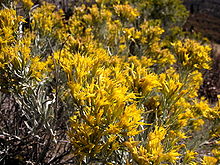Rubber rabbit
| Ericameria nauseosa |
 |
|
Ericameria nauseosa in Oregon |
| Scientific classification |
| Kingdom: |
Plantae |
| (unranked): |
Angiosperms |
| (unranked): |
Eudicots |
| (unranked): |
Asterids |
| Order: |
Asterales |
| Family: |
Asteraceae |
| Tribe: |
Astereae |
| Genus: |
Ericameria |
| Species: |
E. nauseosa |
| Binomial name |
Ericameria nauseosa
(Pall. ex Pursh) G.L.Nesom & G.I.Baird
|
| Synonyms |
Synonymy
- Chondrophora nauseosa (Pall. ex Pursh) Britton
- Chrysothamnus nauseosus (Pall. ex Pursh) Britton
- Chrysocoma nauseosa]] Pall.
- Chrysothamnus frigidus Greene
- Bigelowia nauseosa M.E.Jones
- Chrysothamnus collinus Greene
- Chrysothamnus concolor (A.Nelson) Rydb.
- Chrysothamnus pallidus A.Nelson
- Aster edwardii Kuntze
- Bigelowia juncea Greene
- Chrysothamnus junceus (Greene) Greene
- Chrysothamnus plattensis (Greene) Greene
- Machaeranthera scabrella (Greene) Shinners, syn of var. ammophila
- Aster binominatus Kuntze, syn of var. bigelovii
- Bigelowia bigelovii (A.Gray) A.Gray, syn of var. bigelovii
- Chrysothamnus bigelovii (A.Gray) Greene, syn of var. bigelovii
- Chrysothamnus glareosus (M.E.Jones) Rydb., syn of var. bigelovii
- Chrysothamnus moquianus Greene, syn of var. bigelovii
- Linosyris bigelovii A.Gray, syn of var. bigelovii
- Bigelowia ceruminosa (Durand & Hilg.) A.Gray, syn of var. ceruminosa
- Chrysothamnus ceruminosus (Durand & Hilg.) Greene, syn of var. ceruminosa
- Linosyris ceruminosus Durand & Hilg., syn of var. ceruminosa
- Chrysothamnus angustus Greene, syn of var. consimilis
- Chrysothamnus confinis Greene, syn of var. consimilis
- Chrysothamnus consimilis Greene, syn of var. consimilis
- Chrysothamnus falcatus Greene, syn of var. consimilis
- Chrysothamnus patens Rydb. syn of var. consimilis
- Chrysothamnus pinifolius Greene, syn of var. consimilis
- Chrysothamnus tortuosus Greene, syn of var. consimilis
- Bigelowia graveolens (Nutt.) A.Gray, syn of var. graveolens
- Chrysocoma graveolens Nutt., syn of var. graveolens
- Chrysothamnus dracunculoides (DC.) Nutt., syn of var. graveolens
- Chrysothamnus graveolens (Nutt.) Greene, syn of var. graveolens
- Chrysothamnus laetevirens Greene, syn of var. graveolens
- Chrysothamnus virens Greene, syn of var. graveolens
- Linosyris graveolens (Nutt.) Torr. & A.Gray, syn of var. graveolens
- Chrysothamnus gnaphalodes (Greene) Greene, syn of var. hololeuca
- Chrysothamnus appendiculatus (Eastw.) A.Heller, syn of var. latisquamea
- Chrysothamnus arizonicus (Greene) Greene, syn of var. latisquamea
- Chrysothamnus latisquameus (A.Gray) Greene, syn of var. leiosperma
- Aster leiospermus (A.Gray) Kuntze, syn of var. leiosperma
- Bigelowia leiosperma A.Gray, syn of var. leiosperma
- Chrysothamnus leiospermus (A.Gray) Greene, syn of var. leiosperma
- Aster mohavensis (Greene) Kuntze, syn of var. mohavensis
- Bigelowia mohavensis Greene, syn of var. mohavensis
- Bigelowia mohavensis Greene ex A.Gray, syn of var. mohavensis
- Chrysothamnus mohavensis (Greene) Greene, syn of var. mohavensis
- Bigelowia glareosa M.E.Jones, syn of var. psilocarpa
- Chrysothamnus salicifolius Rydb., syn of var. salicifolia
- Chrysothamnus californicus Greene, syn of var. speciosa
- Chrysothamnus formosus Greene, syn of var. speciosa
- Chrysothamnus macounii Greene, syn of var. speciosa
- Chrysothamnus occidentalis (Greene) Greene, syn of var. speciosa
- Chrysothamnus orthophyllus Greene, syn of var. speciosa
- Chrysothamnus pulcherrimus A.Nelson, syn of var. speciosa
- Chrysothamnus speciosus Nutt., syn of var. speciosa
- Bigelowia turbinata M.E.Jones , syn of var. turbinata
- Chrysothamnus turbinatus (M.E.Jones) Rydb., syn of var. turbinata
|
Ericameria nauseosa (formerly Chrysothamnus nauseosus), commonly known as Chamisa, rubber rabbitbrush, and gray rabbitbrush, is a North American shrub in the sunflower family (Aster). It grows in the arid regions of western Canada, western United States (from the western Great Plains to the Pacific) and northern Mexico.
Two subspecies have been described, nauseosa (the gray form with 14 varieties) and consimilis (the green form with 8 varieties).
Rubber rabbitbrush was moved from the genus Chrysothamnus to the genus Ericameria in a 1993 paper. The findings of a 2003 phylogenetic investigation of Ericameria were consistent with the move of the rubber rabbitbrush from Chrysothamnus to Ericameria. The second edition of the Jepson plant manual and the USDA Germplasm Resources Information Network have adopted the name Ericameria nauseosa.
Ericameria nauseosa is a 2' to 8' perennial shrub. The shrub reproduces from seeds and root sprouts.
It blooms from August to October. It produces pungent-smelling, golden-yellow flowers. Flower heads are made up of 5 small, yellow, tubular disk flowers flowers, and occur in umbrella-shaped terminal clusters.
Leaves, depending on the subspecies, are long and narrow to spatula-shaped. Both the flexible (rubbery) stems and the leaves are greenish-gray with a soft felt-like covering.
Recognized infraspecific taxa from The Plant List with distribution information from Flora of North America and Tropicos
Rabbitbrush, Ericameria nauseosa, has gained popularity as an ornamental xeriscaping shrub in areas where water conservation is important. It thrives in a wide range of coarse, alkaline soils that are common to desert environments. Pruning the shrub back to several inches in early spring, before new growth begins, may help improve the shrub's ornamental value.
...
Wikipedia

